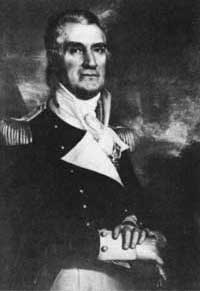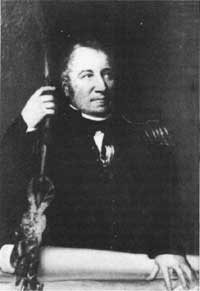|
FORT McHENRY National Monument and Historic Shrine |
 |
 Gen. Samuel Smith. Courtesy Peale Museum. |
 Gen. John Stricker. Courtesy Enoch Pratt Library. |
Baltimore, the British Objective
From the British point of view, Baltimore, which was larger, wealthier, and more important commercially than Washington, presented a more desirable objective than the Capital. If successful, they could sequester the contents of the loaded warehouses, seize the three American war ships nearing completion, and destroy the shipyards which were outfitting privateers. Aside from these materialistic considerations, Cochrane and Ross were not adverse to punishing a city which was a hotbed of anti-British sentiment and from whose harbor had sailed many of the privateers which were successfully raiding British commerce.
Unlike Washington, however, Baltimore was not defenseless. Under the leadership of Maj. Gen. Samuel Smith, merchant, politician, and veteran of the Revolutionary War, it had been preparing for the expected British attack. Smith was far too practical to rely upon the ineffectual Federal Government. He contrived to secure arms, ammunition, and equipment from the Secretary of War and the Governor of the State. He directed the repair of old batteries and the erection of new ones. Militia units were called up for training and brief tours of duty. The expenses incurred by these defense preparations were defrayed by a local committee which had raised $500,000 by popular subscription and loan.
In 1813, this committee had advanced more than $40,000 to the Federal Government for the repair of Fort McHenry. The earthen ramparts of the outer batteries were repaired, and the defective wooden gun platforms and carriages replaced. General Smith, with the consent of the French consul, removed the guns from a French warship in the harbor and had them emplaced at the fort. He also arranged for the installation of furnaces to heat shot. Artillery companies were sent to the fort to reinforce the garrison. Two small works were erected on the Ferry Branch to protect the rear of Fort McHenry, and a small battery was set up at Lazaretto to help protect the entrance to the North West Branch.
Late in August 1814, when a British attack appeared inevitable, a special Committee of Vigilance and Safety was created. This committee raised money to purchase supplies, provided aid to the needy and medical care for the sick soldiers, guarded against defeatism, and maintained law and order in the city. Of utmost importance, it mobilized all citizens not subject to military service for work on defenses. Under its direction a long line of strong entrenchments was erected to guard the eastern approaches to the city.
To defend Baltimore, Smith had at his disposal a force of 12,000, consisting chiefly of Maryland, Pennsylvania, and Virginia militia, some regular army units, and about 400 sailors under Commodore John Rodgers. Reports of the conduct of the untrained militia at Bladensburg did not escape Smith's attention, and he decided to wage a strong defensive action. On September 11, an alarm sounded, warning the citizens of Baltimore that the British fleet had reached the Patapsco. Smith immediately ordered Brig. Gen. John Stricker to lead his brigade toward North Point to intercept the British. His final defense measure was to direct Rodgers to sink vessels across the entrances to both branches of the river.

|
|
Last Modified: Mon, Dec 2 2002 10:00:00 am PDT |


